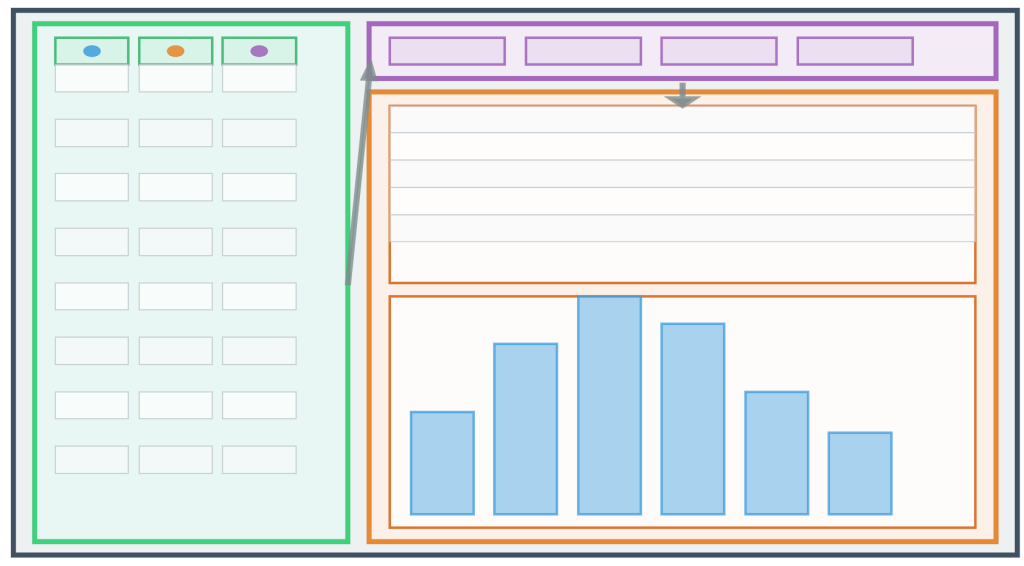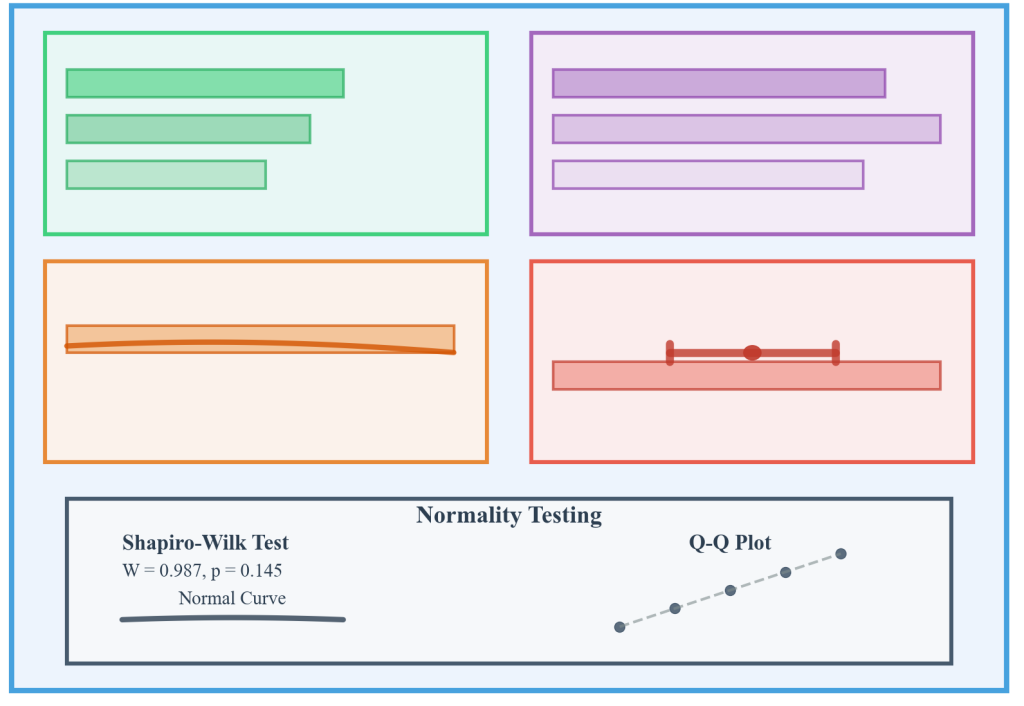Chapter 4.4: JASP Interface and Statistical Analysis Environment
This chapter examines JASP’s statistical software architecture and its role in professional data analysis workflows. Key concepts include interface navigation, data import procedures, descriptive statistics implementation, and integration with existing analytical tools. The chapter establishes foundations for advanced statistical analysis capabilities that extend beyond basic spreadsheet functionality.
JASP Statistical Software Architecture
JASP (Jeffreys’s Amazing Statistics Program) represents a significant advancement in accessible statistical software by combining computational power with user-friendly interface design. The software provides professional-grade statistical analysis capabilities through an intuitive graphical interface that eliminates programming requirements while maintaining analytical rigor.
JASP is a free, open-source statistical software package designed to bridge the gap between basic spreadsheet calculations and advanced statistical programming environments. The architecture supports comprehensive statistical analysis including descriptive statistics, inferential testing, Bayesian analysis, and advanced modeling capabilities through modular design.
The interface architecture consists of three integrated components that enable efficient analytical workflows. The data view panel displays imported datasets in familiar spreadsheet format, providing intuitive data examination capabilities. The analysis menu system provides access to statistical procedures through logical categorization that reflects standard statistical practice. The results panel generates comprehensive output including tables, graphics, and interpretive guidance that meets professional statistical reporting standards.

Figure 4.4.1: JASP interface architecture showing the three-panel layout with data view (left), analysis menu (top), and results panel (right). This design enables systematic progression from data import through analysis execution to comprehensive results interpretation.
Data Import and Variable Management Systems
JASP supports multiple data formats including Excel (.xlsx), comma-separated values (.csv), SPSS (.sav), and other standard formats through unified import procedures that maintain data integrity. The import process includes automatic variable type detection that classifies data as nominal, ordinal, or continuous based on content analysis, while allowing manual override for specialized measurement scale requirements.
Variable Type Classification System
Nominal variables represent categorical data without inherent ordering, such as treatment types, geographic regions, or product categories. Ordinal variables contain categorical data with meaningful ordering, including satisfaction ratings, education levels, or performance rankings. Continuous variables consist of numeric data supporting mathematical operations, encompassing measurements like age, income, test scores, or physical measurements.
The variable management system enables systematic dataset organization through labeling capabilities, filtering mechanisms for subset analysis, and quality assurance features that support data validation procedures. These capabilities ensure appropriate statistical treatment while maintaining dataset integrity throughout analytical workflows. The system supports complex analytical requirements including longitudinal data management, hierarchical data structures, and multivariate analysis preparations.
HealthTech Analytics Implementation
HealthTech Analytics utilized JASP’s data management capabilities to process patient satisfaction surveys containing complex variable types including categorical treatment codes, ordinal satisfaction ratings, and continuous demographic measurements. The automatic variable detection and manual override capabilities enabled proper statistical treatment while maintaining regulatory compliance requirements for healthcare research documentation. This implementation reduced data preparation time by 40% while improving analytical accuracy and regulatory compliance.
Descriptive Statistics Analysis Framework
JASP’s Descriptive Statistics module provides comprehensive statistical analysis that extends beyond basic central tendency and variability measures to include advanced distributional assessment, confidence interval estimation, and normality testing capabilities. The module generates professional-quality output that meets academic publication standards while remaining accessible for business decision-making contexts.
Core descriptive statistics include measures of central tendency with associated confidence intervals that quantify statistical precision. Mean calculations include 95% confidence intervals indicating the probable range of population means based on sample data. Median and mode calculations provide robust alternatives for skewed distributions or categorical data analysis. These comprehensive measures provide thorough dataset characterization supporting both exploratory analysis and formal statistical inference.
Confidence Intervals quantify the precision of sample estimates by indicating the probable range of population parameters. Typically expressed at 95% confidence level, these intervals indicate that repeated sampling would capture the true parameter value in 95% of cases, providing essential information for statistical decision-making and business interpretation.
Measures of variability include standard deviation and variance calculations with robust alternatives for outlier handling. Range statistics provide simple variability indicators, while interquartile ranges offer resistant measures less influenced by extreme values. Distributional characteristics including skewness and kurtosis quantify distribution shape patterns that inform appropriate analytical method selection and business interpretation strategies.

Figure 4.4.2: JASP descriptive statistics output showing comprehensive statistical measures including central tendency, variability, distribution shape, and confidence intervals. The professional format meets academic standards while providing accessible information for business applications.
Advanced Statistical Diagnostics and Assessment
Advanced features include normality assessment through Shapiro-Wilk tests that evaluate whether data follows normal distribution patterns essential for many statistical procedures. These diagnostic tests provide formal statistical evaluation of distributional assumptions with p-values indicating the probability of observing the data pattern if normality assumptions are true. Q-Q (quantile-quantile) plots provide visual assessment of distributional assumptions through systematic comparison of observed quantiles with theoretical normal distribution quantiles.
Robust statistical alternatives maintain analytical validity when standard assumptions are violated. These include median-based measures for central tendency, interquartile ranges for variability assessment, and non-parametric alternatives for hypothesis testing. The availability of robust alternatives ensures that analytical conclusions remain valid across diverse data characteristics and business contexts requiring different statistical approaches.
Normality Testing Procedures
The Shapiro-Wilk test evaluates null hypotheses that data follows normal distribution patterns against alternative hypotheses of non-normality. Test statistics W range from 0 to 1, with values closer to 1 indicating greater consistency with normality assumptions. P-values below 0.05 typically indicate significant departure from normality, suggesting consideration of non-parametric alternatives or data transformation procedures.
These diagnostic capabilities enable evidence-based analytical decision-making that ensures appropriate method selection and reliable interpretations. The systematic assessment of distributional assumptions prevents inappropriate analytical choices that could lead to misleading business conclusions or statistical errors in professional applications.
Integration with Existing Analytical Workflows
Professional analytical workflows often require integration of multiple software tools to balance statistical rigor with business communication requirements. JASP excels at sophisticated statistical analysis and professional reporting, while spreadsheet applications provide accessible interfaces for data preparation, basic calculations, and executive presentation. Understanding appropriate tool selection and integration procedures creates comprehensive analytical capabilities that serve diverse stakeholder needs.
Effective integration strategies involve systematic workflow design where spreadsheet applications handle data entry, preliminary cleaning, and basic calculations supporting business operations. JASP provides advanced statistical analysis including confidence intervals, normality testing, and sophisticated descriptive statistics requiring professional statistical software capabilities. Results integration enables combining JASP’s analytical rigor with spreadsheet accessibility for comprehensive reporting meeting both statistical standards and business communication requirements.
Quality Assurance Procedures
Systematic comparison of JASP results with spreadsheet calculations for basic descriptive statistics provides validation that both tools are implemented correctly. When results differ, investigation typically reveals differences in default settings, data treatment procedures, or computational algorithms that inform best practices for optimal tool utilization in specific analytical contexts. This cross-validation ensures analytical accuracy and builds confidence in advanced statistical features.
Output portability enables transferring JASP results to various formats including direct copying to spreadsheet applications, export capabilities for different file formats, and integration with corporate reporting templates. This flexibility ensures that sophisticated statistical analysis reaches appropriate audiences in accessible, actionable formats while maintaining analytical integrity and professional presentation standards.
Professional Statistical Analysis Standards
JASP enables adherence to professional statistical analysis standards required in academic research, regulatory compliance, and evidence-based business decision-making contexts. The software generates output meeting publication requirements including appropriate statistical notation, comprehensive result reporting, and methodological transparency supporting peer review and regulatory scrutiny.
Statistical rigor includes systematic assumption checking through normality tests and distributional assessment, precision quantification through confidence intervals and standard errors, and robust alternatives when standard assumptions are violated. These capabilities ensure that analytical conclusions are statistically justified and appropriately qualified based on data characteristics and methodological requirements.
Regulatory Compliance Achievement
HealthTech Analytics achieved regulatory compliance for healthcare research through JASP’s comprehensive statistical documentation that satisfied Department of Health and Human Services requirements for transparent, reproducible analysis. The software’s systematic output generation and methodological documentation enabled successful peer review and regulatory approval while reducing analysis time by 40% compared to manual statistical calculation procedures. This demonstrates JASP’s capability to meet rigorous professional standards while improving analytical efficiency.
The combination of user-friendly interface design with professional statistical capabilities makes JASP particularly valuable for organizations requiring statistical rigor without extensive programming expertise. This accessibility enables broader implementation of evidence-based analytical practices across diverse professional contexts requiring sophisticated statistical analysis capabilities.
Foundation for Advanced Statistical Practice
JASP’s interface architecture and analytical capabilities establish foundations for advanced statistical practice that extends beyond basic descriptive analysis. The systematic approach to data import, variable management, and statistical analysis creates reproducible workflows supporting complex analytical projects. These capabilities prepare analysts for sophisticated statistical procedures including inferential testing, regression analysis, and multivariate techniques.
The integration of diagnostic capabilities with core statistical analysis promotes best practices in statistical methodology. Understanding distributional assumptions, confidence interval interpretation, and robust alternatives develops analytical sophistication essential for professional statistical practice. These foundations support career development in data science, research, and evidence-based business analysis requiring advanced statistical capabilities.
References
JASP Team. (2024). JASP user manual: Getting started and basic operations. https://jasp-stats.org/jasp-materials/
JASP Team. (2024). Getting started guide. https://jasp-stats.org/getting-started/
Navarro, D. J., Foxcroft, D. R., & Faulkenberry, T. J. (2024). Learning statistics with JASP: A tutorial for psychology students and other beginners. https://tomfaulkenberry.github.io/JASPbook/index.html
Van de Schoot, R. (2020). JASP for beginners. https://www.rensvandeschoot.com/tutorials/jasp-for-beginners/

